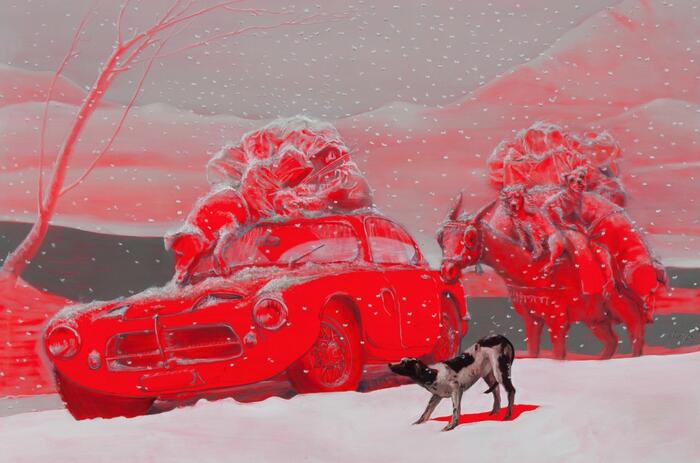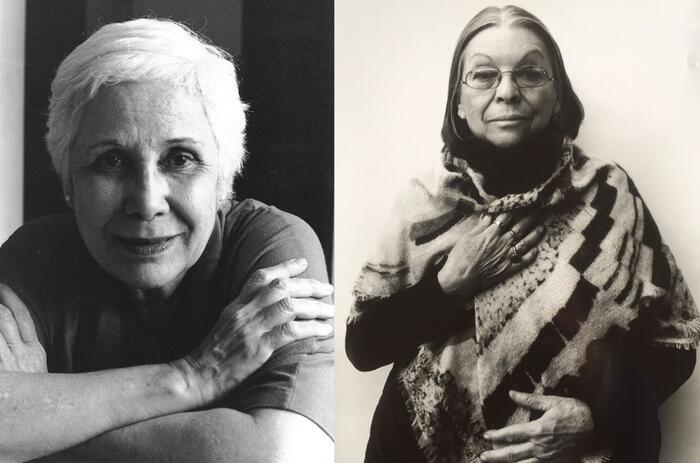MOVING GRAVES, REVOLVED TERRITORIES, RESISTANCE IN A NET - GRADA KILOMBA, LUANA VITRA AND ABDIAS NASCIMENTO
In Brazil's largest open-air contemporary art center, with an enviable connection between nature and visuality, nautical elements have curiously been the driving force behind important commissioned works. Now at Inhotim, they are central to the metaphors that evoke previous unwanted flows of circulation and, at the same time, act as a reference so that they are not repeated - in this case, the slave trade originating in Africa, whose survivors worked, among other activities, in the exploitation of minerals that sustained the economy of this part of Brazil, today, Minas Gerais.

Arjan Martins, an artist from Rio de Janeiro who started painting later in life and is now a celebrated name in the medium nationwide, brings the theme of the criminal economy of yesteryear to large-scale canvases. He also used it prominently at the 34th São Paulo Biennial as the author of Complexo Atlântico (Rope), an installation with a large anchor on one of the floors of Oscar Niemeyer's (1907-2012) iconic modernist building. For Inhotim, however, he signed a more poetic and silent reinterpretation of his own previous project in 2022. At one of the highest points of the immense artistic and botanical institution, he installed five buoys, used as nautical orientation elements, which, when moved to that particular place, offered themselves up to the weather, strong currents of air, the action of birds, etc. Today, Birutas is part of the museum's collection and multiples are sold in the museum's store, which is more accessible to the general public.
Grada Kilomba, a Portuguese artist who lives between Lisbon and Berlin, has restructured a project previously seen in her hometown and in London. O Barco is an ambitious installation that is activated with performances by dancers and percussionists and that will remain in Inhotim for two years (with other actions planned to take place in the work during this stay). In a space that has already hosted major pieces by William Kentridge and Janet Cardiff, the artist, who was part of the curatorial team for the most recent edition of the Bienal de SP last year and who has already exhibited in important contemporary centers in the country, such as the Pinacoteca de São Paulo in 2019, does not shy away from revisiting stories that involve taboos, painful reminiscences and that deal with the death drive.
“One boat, one cargo hold/ One cargo hold, one load/ One load, one story/ One story, one piece/ One piece, one life/ One life, one body (...)”, writes the artist in the poem that accompanies the work, recited by an ensemble during the performance. The 134 blocks of calcined wood arranged over 32 meters that reconstitute the diagram of the tumbrel boat go beyond the physical dimension of the macabre program so central to colonialism and remind us of every subjectivity, every potentiality that succumbed to the mercantile dynamics of the time. The piece is powerful, offering no concessions and giving Inhotim a dimension beyond the sensory and harmonious aspects, a facet so widely propagated by advertising and other media around the world.
In the same series of openings, Paulo Nazareth from Minas Gerais opened Esconjuro, a project that will also run until the winter of 2025. The multidisciplinary program spreads across the exhibition room, square and gardens of the cultural center and explores the displacement character of the artist's work, which combines the binomial of art and life like few others. And in the group show Ensaios sobre Paisagem (Essays on Landscape), which exhibits works by Aislan Pankararu, Ana Cláudia Almeida, Castiel Vitorino Brasileiro and Zé Carlos Garcia, perhaps a well-deserved spotlight should fall on Garcia, one of the great names in Brazilian three-dimensional art, who exhibits sculptures in the section that house references from the history of art and use materials that feed on exhaustion/renewal and decay/rebirth with a markedly organic tone.
Inhotim's program also highlights commissioned projects or those of a temporary nature, but with an extended duration, which reshape its profile. Luana Vitra, originally from Contagem, a town on the outskirts of the Belo Horizonte area, is installing Giro at the Galeria Marcenaria, which deals with a variety of materials and seems more mature than Pulmão da Mina, which was shown at the last edition of the São Paulo Biennial last year. Through planned and plastic arrangements of ceramics, copper, iron, fabric and iron ore itself, Luana metamorphoses the old woodworking space and creates a locus that approaches the sacred - but with Afro-Brazilian overtones - and, at the same time, mirrors the economy of the surrounding area, famous for the continuous extraction of minerals in different production cycles. It's almost a poetic rebirth of what was apparently only on the level of dispossession.
Finally, Abdias Nascimento (1914-2011) has become central to the institute's recent programming. Now, the last chapter of this journey is presented. Fourth Act: Quilombismo - Documents of a Pan-Africanist Militancy focuses the curatorial effort on the concept of quilombismo developed by the artist, thinker, politician, playwright and activist, which is based on collective well-being and proposes joint strategies of resistance for black people. In terms of exhibition design, there is a display of various works, especially paintings, by Abdias and an extensive network of partners, as well as a meticulous selection of documents, photographs, letters, newspapers, catalogs and books, among other items.
The first act of the tetralogy was Abdias Nascimento, Tunga e o Museu de Arte Negra; the second chapter, Dramas para Negros e Prólogos para Brancos; and the third, Sortilégio. A large part of the collection belongs to Ipeafro (Institute for Afro-Brazilian Research and Studies), run by Elisa Larkin, Abdias' widow.
The dive into the work of Abdias Nascimento and quilombismo should not be interrupted. Bonaventure Soh Bejeng Ndikung, who has been announced as the curator of the next São Paulo Biennial, the 36th, in 2025, studies the Brazilian's work and held an exhibition on the subject in Berlin last year.
Grada Kilomba – O Barco; Paulo Nazareth – Esconjuro; Ensaios sobre Paisagem
From April 13th, 2024
Inhotim - Rua B, 20, Brumadinho, MG, Brazil.
Luana Vitra – Giro; Abdias Nascimento e o Museu de Arte Negra, Quarto Ato: O Quilombismo – Documentos de uma Militância Pan-Africanista
From November 11, 2023
Inhotim - Rua B, 20, Brumadinho, MG, Brazil.









